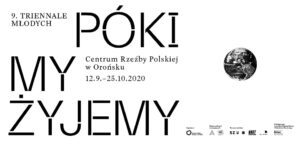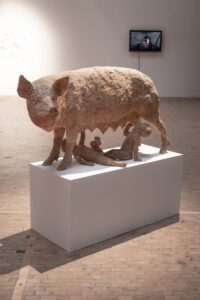Katie Zazenski
 On a gigantic, anthropomorphized sun-like circle, made of peach satin and suspended on the back wall of the exhibition hall, is the declaration Wierzę w Bezinteresowność Sztuki (I believe in the selflessness of art). Shirts and pants arranged in the form of two angel-like figures are surrounded by hand-stitched text bubbles. Strongly reminiscent of the American radical theater group Bread and Puppet, this wall piece by Patryk Różycki, The Greatest Sun Seen From the Earth Touches Our Relation, feels like a greeting, an invitation, a confession even, and fills the entire exhibition space with a spirit of curiosity, experimentation, progressiveness, and hope. The energy courses through the 9th Young Triennale ‘So Long As We Still Live’, and is an offering in a time of unrelenting global stress, fear, pain, and frustration.
On a gigantic, anthropomorphized sun-like circle, made of peach satin and suspended on the back wall of the exhibition hall, is the declaration Wierzę w Bezinteresowność Sztuki (I believe in the selflessness of art). Shirts and pants arranged in the form of two angel-like figures are surrounded by hand-stitched text bubbles. Strongly reminiscent of the American radical theater group Bread and Puppet, this wall piece by Patryk Różycki, The Greatest Sun Seen From the Earth Touches Our Relation, feels like a greeting, an invitation, a confession even, and fills the entire exhibition space with a spirit of curiosity, experimentation, progressiveness, and hope. The energy courses through the 9th Young Triennale ‘So Long As We Still Live’, and is an offering in a time of unrelenting global stress, fear, pain, and frustration.
Curated by Marta Czyż, this exhibition at the Center of Polish Sculpture in Orońsko (just over 100 km south of Warsaw), features the work of 32 artists who worked in conversation with five mentors. The curatorial statement asks if artists will save the world through their sensitivities. There’s a familiar reverence to this text, which can also be felt in several of the works, evoking a very 1960s Bruce Nauman idea of artists revealing mystic truths. Czyż says that she was searching for visionaries, finding them by creating an open call. The final selection was made after individual conversations with each applicant. It’s clear that this initial meeting helped forge the distinct sense of honest inquiry, self-awareness and critical awareness that each artist contributes to this whole. Working together, they (curator, mentors and artists) discussed shared concerns, such as reducing the use of toxic materials and creating a ‘best practices’ code of ethics.
The exhibition catalogue contains the resulting texts which range from reminders about proper recycling habits to more extensive manifestos, such as Patrycja Cichosz’s Flexibility: “The strategy should be modifiable and adaptable. More broadly – I adjust to the situation as far as possible and I learn new skills, etc … Inner conviction: I do what is in accordance with my moral compass. Adequacy: My activity takes into consideration the current reality… I know I will not save the whole world at once … While working with others, I respect their boundaries and listen to what they have to say.”
Her work in the exhibition, Anti-Repressive Brochure (2020), features the critical information one needs when being detained by police, a text which was originally issued as I Refuse to Testify by the organization Anarchist Black Cross. I was handed a similar leaflet during a protest against unprecedented police violence toward the LGBT community this past August in Warsaw.
As Czyż reminds us, art is and always has been a response to changing circumstances. Mentor Urszula Zajączkowska asks for the space for young artists to grow and the courage to break down and build anew our systems of thinking, making, living, and being. In fact, the piece that we are physically confronted with first is Made in Chain (2019), a ceramic floor piece by Aleksandra Jagła. It’s estimated that there are many hundreds of North Korean citizens engaged in a form of modern slavery here in Poland, a rather secret contingent of forced-laborers, only topically out of view, working in the shipyards and other easily managed sites, primarily in the north. The global crisis is not only climatological. It is social and it is ethical, our culpability is in our veiled consequence-less silence.

Katarzyna Malejka takes a more nuclear approach to powerlessness. I have One Better Piece of Furniture (2020) features a group of Play-Doh figures (borrowed from the artist’s son) enacting some form of us–vs–them, staged around an upturned couch. The pandemic inverted what felt like everything, and so became an amplifier for domestic violence. How do we rely on our human community when we are confined, when the fabric of social trust has been eroded like a deforested hillside? In her code, Maria Nova references the centenarian James Lovelock’s theories of the Novacene: “ecological crisis (and climate crisis connected with it) is a crisis in the functioning of the home: it is multidimensional, in essence it concerns social life. In the Anthropocene, paradoxically, we have forgotten about ourselves, about home, the need to create networks, about interspecies equality: ecology towards the other, including the other in you.”
What we really see in So Long As We Still Live is this call to examine our patterns, habits, positions, systems and choices with full vulnerability and risk. Again I refer to Różycki, whose wall text closes with the sentiment that his work “…is my gift, my attempt to express love full of hope. The only thing I have is my faith in it.”
Faith is necessary because no matter how staunchly one rejects the notion of nostalgia, change is rarely easy, comfortable, nor a guarantor of something better. Kacper Szalecki combed through OLX (an online marketplace somewhere between Craigslist and eBay) to find cast Polish eagles made between 1947-1989 for his installation WEAPONS/TRANSFORMATIONS (Working Title) (2020). These national emblems were melted down and recast into riddled, clawed, finger-like objects, held together by pink toe separators (the little foam objects they stick on your feet at the nail salon when you’re in for a pedicure). A looped video documents the founding process and, despite the obvious metaphor, the work retains an air of hermetic magic. A talisman for 2020 that stretches beyond the borders of Poland.
Founding uses and produces any number of toxic particulates and gasses throughout the process, from silica dust to an array of heavy metals. Which leads us directly to this other primary concern of these artists: ecologically ethical materials and our need to confront the cycles of waste and toxicity (material and psychological) that the art world is responsible for. Julia Łukasiak essentially asks us to confront this dilemma: do we compromise the concept for the sake of sustainability, at the risk of making a less-good work?
Rhea Silvia (2020) by Ida Karkoszka is an ouroboric monument to consumerism – materially engineered to be fully biodegradable, she is a sow version of the she-wolf complete with her own version of suckling Polish twins. Tomek Haładaj fills one of the sizable walls with his series of seven ‘paintings’: surrealist, folk-like compositions of found and recycled materials that are a quite direct proposition to the future of painting.

The collective works are somatic in scale and process, and it’s a relief to be able to measure something not in nanometers or degrees or minutes of a doomsday clock. In his code, painter Tomasz Paszkowicz writes, “I will risk a semantic shift that being an artist is an attitude, not a profession or character. A most critical attitude, affecting the performative nature of life.” And it is exactly this sentiment that the 9th Young Triennale embodies. We, as a species, are on a constant search which is now matched with a dire need to reconstruct just about every system we have ever devised. A task that could have overwhelmed a curator, it was both comforting and exciting to feel a sense of hope, to feel this beautiful welcoming into an alchemical mechanism of sorting out the next version of life. We can’t go back, and the 9th Triennial makes me feel really ok about that.
Volume 35 no 2 November / December 2020

Sounds an interesting show. Alarming about exploitation of N Korean Labour – which I found more about by googling- it seems the N Korean government is involved. I could not find more about the artist Aleksandra Jagla and would like to know what her piece about this issue was like.